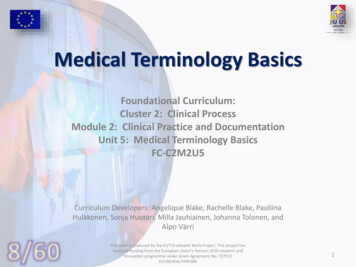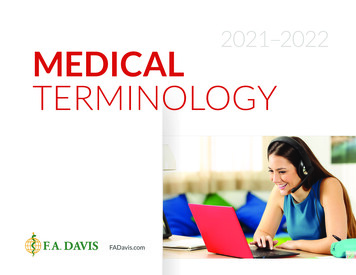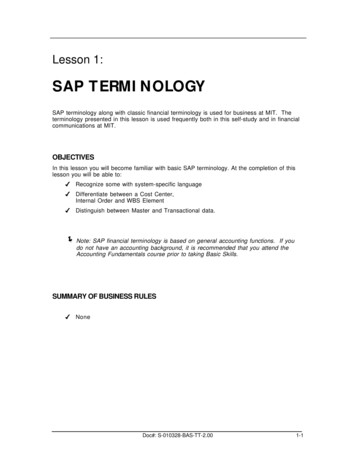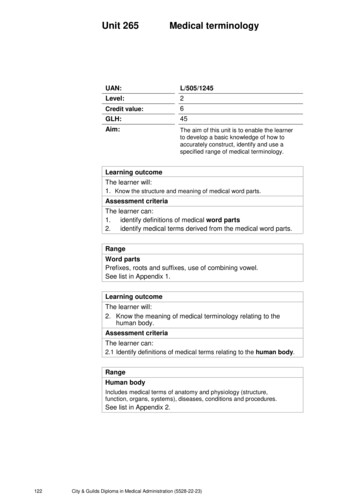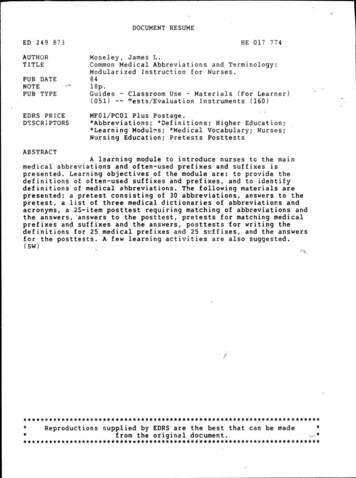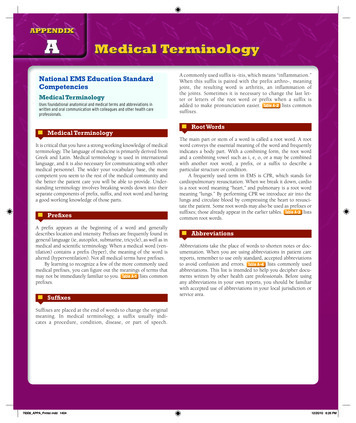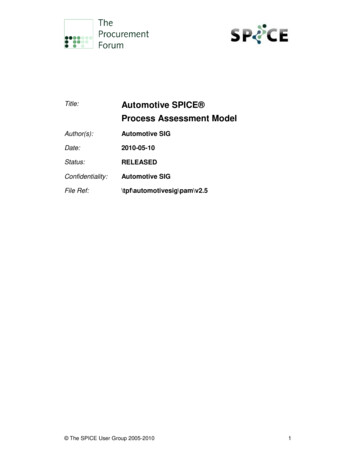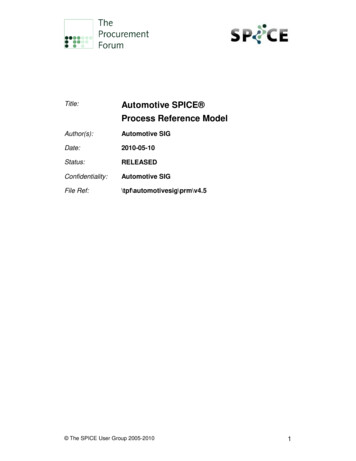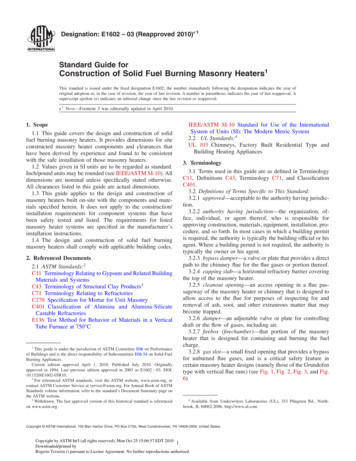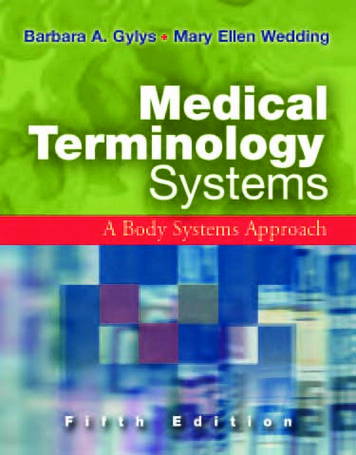
Transcription
Gylys FM 10/01/2004 12:27 PM Page iMedicalTerminologySystemsA Body Systems Approach
Gylys FM 10/01/2004 12:27 PM Page iiBlank page
Gylys FM 10/01/2004 12:27 PM Page iiiFIFTH EDITIONBarbara A. Gylys, MEd, CMA-AProfessor EmeritaCollege of Health and Human ServicesMedical Assisting TechnologyUniversity of ToledoToledo, OhioMary Ellen Wedding, MEd, MT(ASCP), CMA, AAPCProfessor of Health ProfessionsCollege of Health and Human ServicesUniversity of ToledoToledo, OhioMedicalTerminologySystemsA Body Systems ApproachF. A. DAVIS COMPANY Philadelphia
FA Davis brochure 4.09/29/042:32 PMPage 2Medical terminology ispresented in a clear andconcise manner, usingthe classic word-buildingand body systemsThe pages of Medical Terminology Systems: A Body Systems Approach, 5th Editionapproach to learning.Chapter Outlinesto orient student to each chapter’s content(see page 107)Key Terms highlighted in thebeginning of each chapter(see page 108)Abbreviationsfor common terms(see page 136)
FA Davis brochure 4.09/29/042:32 PMPage 3Brilliant Full-Color Illustrationsthat leap from the pageAnatomy That’s Detailedin enlightening, clarifying waysIllustrations bringmedical terminology tolife, offering a visualcomponent that enhancesthe learning experienceand provides a uniqueperspective to betterunderstand the terminology.
FA Davis brochure 4.09/29/042:32 PMPage 4Detailed Medical Recordswith each body system, that providereal-life examples(see page 146)Fully Revised Table Formatfor better retention and quick learning(see page 128)Pronunciationswith all terms(see page 116)More Organized,user-friendly headingsIncludes Suffixesand their meanings
FA Davis brochure 4.09/29/042:32 PMPage 1Worksheets Containing Exercisesand Activities are featured in eachchapter, to help track progress andto review for quizzes and tests(see pages 142-143)Packaged with Interactive Medical Terminology 2.0on CD-ROM. Designed to be used in tandem withthe text, this interactive software helps students mastermedical terminology. IMT 2.0 includes: Nearly 1200 test items Choice of basic or advancedtesting modes Interactive exercises suchas crossword puzzles, worddrag-and-drop, and wordscrambles Comprehensive scorereporting for each exercise
Gylys FM 10/01/2004 12:27 PM Page viiiF. A. Davis Company1915 Arch StreetPhiladelphia, PA 19103www.fadavis.comCopyright 2005 by F. A. Davis CompanyCopyright 1983, 1988, 1995, and 1999 by F. A. Davis Company. All rights reserved. This product is protected by copyright. No part of it may be reproduced, stored in a retrieval system, or transmitted in any form or by any means, electronic, mechanical, photocopying, recording, or otherwise, without written permission from the publisher.Printed in the United States of AmericaLast digit indicates print number: 10 9 8 7 6 5 4 3 2 1Acquisitions Editor: Andy McPheeDevelopmental Editor: Brenna MayerArt and Design Manager: Joan WendtAs new scientific information becomes available through basic and clinical research, recommended treatments and drugtherapies undergo changes. The author(s) and publisher have done everything possible to make this book accurate, upto date, and in accord with accepted standards at the time of publication. The author(s), editors, and publisher are notresponsible for errors or omissions or for consequences from application of the book, and make no warranty, expressedor implied, in regard to the contents of the book. Any practice described in this book should be applied by the reader inaccordance with professional standards of care used in regard to the unique circumstances that may apply in each situation. The reader is advised always to check product information (package inserts) for changes and new informationregarding dose and contraindications before administering any drug. Caution is especially urged when using new or infrequently ordered drugs.Library of Congress Cataloging-in-Publication Data0–8036–1249–XAuthorization to photocopy items for internal or personal use, or the internal or personal use of specific clients, is grantedby F. A. Davis Company for users registered with the Copyright Clearance Center (CCC) Transactional Reporting Service,provided that the fee of .10 per copy is paid directly to CCC, 222 Rosewood Drive, Danvers, MA 01923. For those organizations that have been granted a photocopy license by CCC, a separate system of payment has been arranged. The feecode for users of the Transactional Reporting Service is:/ .10.
Gylys FM 10/01/2004 12:27 PM Page ixThis book is dedicated with loveto my best friend, colleague,and husband, Julius A. Gylysandto my children,Regina Mariaand Julius Anthonyandto Andrew Masters,Julia Masters, Caitlin Masters,Anthony Mychal Bishop-Gylys,and Matthew James Bishop-GylysB.A.G.to my little ones,Andrew Arthur Kurtz,Katherine Louise Kurtz,Daniel Keith Wedding, II,Carol Ann Estelle Wedding,Jonathan Michael Kurtz,Donald Keith Wedding, III,and Emily Michelle WeddingM.E.W.
Gylys FM 10/01/2004 12:27 PM Page xBlank page
Gylys FM 10/01/2004 12:27 PM Page xiAcknowledgmentsThe authors would like to acknowledge the valuable contributions of F. A. Davis’s editorial andproduction team who were responsible for this project: Andy McPhee, Acquisitions Editor, who provided the overall design and layout for thefifth edition. His vision of the work helped focus the authors at the onset of the project and his guidance throughout this endeavor provided cohesiveness. Susan Rhyner, Manager of Creative Development, whose expertise and care areevident in the quality of support staff she selected for the fifth edition. We are especially grateful for her continued support and help whenever it was needed. Margaret Biblis, Publisher, Health Professions and Medicine, whose untiring “behindthe-scenes” efforts are evident in the quality of the finished product. Brenna Mayer, Developmental Editor, whose careful and conscientious edits andsuggestions for the manuscript are evident throughout the entire work. Her untiringassistance and support during this project are deeply appreciated and the authorsextend their sincerest gratitude. Anne Rains, Artist, who developed high-quality illustrations throughout the textbook.Her ability to capture in line and color the words and concepts envisioned by theauthors is outstanding. The authors wish to acknowledge her artistic talents and thankher for being a part of this project.In addition, we wish to acknowledge the many, exceptionally dedicated publishing partnersthat helped in this publication: Robert Butler, Production ManagerMimi McGinnis, Managing EditorJoan Wendt, Design ManagerJack Brandt, Illustrations SpecialistKirk Pedrick, Senior Developmental Editor, Electronic PublishingRalph Zickgraf, Manager, Electronic PublishingMelissa Reed, Assistant Editor of DevelopmentKimberly Harris, Administrative Assistant.We also extend our sincerest appreciation to Neil Kelly, Director of Sales, and his staff of salesrepresentatives whose continued efforts have undoubtedly contributed to the success of thistextbook.xi
Gylys FM 10/01/2004 12:27 PM Page xiiBlank page
Gylys FM 10/01/2004 12:27 PM Page xiiiReviewersWe sincerely thank the clinical reviewers who read and edited the manuscript and provideddetailed evaluations and ideas for improving the text and illustrations:Ann M. Barrow, MSN, RNCoordinator of College RelationsCollege of NursingVillanova UniversityVillanova, PennsylvaniaKatie Barton, LPN, BA, NMCAMedical Assistant CoordinatorKerr Business CollegeAugusta, GeorgiaLisa Morris Bonsall, RN, MSN, CRNPIndependent Clinical ConsultantWest Chester, PennsylvaniaJohn Clouse, MSR, RT(R)Associate ProfessorDepartment of RadiographyOwensboro Community CollegeOwensboro, KentuckyMichael W. Cook, MA, RRT, RCPProfessorDepartment of Respiratory TherapyMountain Empire Community CollegeBig Stone Gap, VirginiaCollette Bishop Hendler, RN, BS, CCRNClinical Leader, Intensive Care UnitAbington Memorial HospitalAbington, PennsylvaniaSue Hunt, MA, RN, CMAProfessor and CoordinatorDepartment of Medical AssistingMiddlesex Community CollegeLowell, MassachusettsCarol MaskerInstructor, Medical TerminologyMorris County School of TechnologyDenville, New JerseyKay A. Nave, CMA/MRTProgram Director, Medical Assisting ProgramMedical DepartmentHagerstown Business CollegeHagerstown, MarylandMichelle Shipley, MS, RHIA, CCSDirector and Assistant ProfessorHealth Information TechnologyWashburn UniversityTopeka, KansasPatti A. Fayash, CMA, CCSEvening Adult CE InstructorSchuykill Technology CenterFrackville, PennsylvaniaCoderMedical Records DepartmentHazleton Healthcare Alliance,Broad Street CampusHazleton, Pennsylvaniaxiii
Gylys FM 10/01/2004 12:27 PM Page xivxivReviewersIn addition, we wish to acknowledge the following individuals who edited portions of themanuscript:Suzanne Wambold, PhD, RN, RDCS, FASEDirector of the CardiovascularTechnology ProgramUniversity of ToledoToledo, OhioCraig Patrick Black, PhD, RRT-NPSRespiratory Care ProgramUniversity of ToledoToledo, OhioSuzanne Spacek, MEd, RRT-NPS, CPFTDirector, Respiratory Care ProgramUniversity of ToledoToledo, OhioJudith A. Ruple, PhD, RN, NREMT-PDirector of the Emergency MedicalHealth Services ProgramUniversity of ToledoToledo, OhioLastly, we feel it is only appropriate to acknowledge our deepest gratitude to Robert H. Craven,Jr., President, for his continued support of our publication efforts on this, the 125th anniversary of F. A. Davis Company, a family-owned business. In 1981 (25 years ago), Mr. Craven,through Mr. Robert Martone, Publisher, awarded these two authors an initial contract for theBody Systems textbook. We thank Mr. Craven and Mr. Martone for giving us the opportunity tobecome authors for one of the most successful and prestigious medical textbook publishingcompanies.
Gylys FM 10/01/2004 12:27 PM Page xvPrefaceThe fifth edition of Medical Terminology Systems: A Body Systems Approach lives up to its well-established track record of presenting medical word building principles based on a competencybased curricula. Systems is designed with the educational foundation of a textbook-workbookformat that complements traditional lecture and classroom teaching methods. The purpose ofthe book is to help students learn medical terminology so they can effectively communicatewith other members of the healthcare team. A variety of pedagogical features will help themdevelop a strong foundation in medical terminology and broaden their medical vocabulary.Although the study of medical terminology demands hard work and discipline, various selfpaced activities offer interest and variety to the learning process.All of the changes in the fifth edition are structured to make learning easier and improveretention of medical terms. Perhaps the most striking changes to this edition are the all-new,visually impressive, full-color illustrations. The artwork is specifically designed to present accurate and aesthetically pleasing representations of anatomical structures, disease conditions,and medical procedures. At the same time, the illustrations enhance course content in newand interesting ways, provide a clearer perspective for the reader, and promote long-lastinglearning.Another new feature of the fifth edition is the omission of possessive forms of alleponyms, (such as Bowman capsule, Cushing syndrome, and Parkinson disease). Medical dictionaries as well as the American Association for Medical Transcription and the American MedicalAssociation support these changes. The fifth edition also contains updated, comprehensivelists of medical abbreviations and their meanings, including a “do not use” abbreviations listmandated by the Joint Commission on Accreditation of Healthcare Organizations.Each chapter incorporates the most current technological changes in medicine.Educators and practitioners in various healthcare disciplines have provided excellent suggestions for this edition, and many of those suggestions have been integrated into the text toaugment its educational effectiveness. Pharmacology information has been significantlyexpanded and now includes commonly used drugs, their generic and trade names, and theirmodes of action.The popular, basic features of the previous edition remain intact but have beenexpanded and enhanced. Here’s a breakdown of those features: Chapter 1 explains the techniques of medical word building using basic wordelements. Chapter 2 categorizes major surgical, diagnostic, symptomatic, and grammaticalsuffixes. Chapter 3 presents major prefixes of position, number and measurement, direction,and other parameters. Chapter 4 introduces anatomical, physiological, and pathological terms. Combiningforms denoting cellular and body structure, body position and direction, regions of thebody, and additional combining forms related to body structure, diagnostic methods,and pathology are also presented. General diagnostic and therapeutic terms aredescribed and provide a solid foundation for specific terms addressed in the bodysystem chapters that follow.xv
Gylys FM 10/01/2004 12:27 PM Page xvixviPreface Chapters 5 to 15 are organized according to specific body systems and may be taughtin any sequence. These chapters include key terms; anatomy and physiology; combining forms, suffixes, and prefixes; pathology; diagnostic, symptomatic, and relatedterms; diagnostic and therapeutic procedures; pharmacology; abbreviations; learningactivities; and medical record activities. All activities allow self-assessment and evaluation of competency. Appendix A: Answer Key contains answers to each learning activity to validate competency and provide immediate feedback for student assessment. Appendix B: Abbreviations includes an updated, comprehensive list of medical abbreviations and their meanings. Appendix C: Glossary of Medical Word Elements contains an alphabetical list ofmedical word elements and their meanings. Appendix D: Index of Genetic Disorders lists genetic disorders presented in the textbook. Appendix E: Index of Diagnostic Imaging Procedures lists radiographic and otherdiagnostic imaging procedures presented in the textbook. Appendix F: Index of Pharmacology lists medications presented in the textbook. Appendix G: Index of Oncological Terms lists terms related to oncology presented inthe textbook.Instructor’s Resource DiskThe Instructor’s Resource Disk (IRD) features many new and some familiar teaching aidscreated to make your teaching job easier and more effective. The supplemental teaching aidsit provides can be used in various classroom settings—traditional classroom, distance learning,or independent studies. The IRD consists of an Activity Pack, three PowerPoint presentations,and a computerized test bank in Brownstone, a powerful test-generation program.Activity PackThe Activity Pack* contains a wealth of information and resources for you, including: Question Bank. The questions and answers in this popular section are taken from theBrownstone Computerized Test Bank found elsewhere on the IRD. These multiple-choiceand true/false questions are only a small sample of the more than 1,100 test items available in the Brownstone test bank. Questions are available for each body-system chapter. The multiple-choice and true/false questions mirror the testing format used onmany allied health national board examinations. Suggested Course Outlines. Course outlines are provided to help you plan the bestmethod of covering the material presented in the textbook. Student and Instructor Directed Activities. These comprehensive teaching aids are newlydeveloped for this edition. They provide an assortment of exercises for each bodysystem chapter that offers variety and interest to the course material. You can selectfrom the various activities and determine if they are to be used as required content orsupplemental material, and whether the activities are to be undertaken individually oras a group project. If group projects are selected, a Peer Evaluation Form is available. Community and Internet Resources. This section provides updated and expandedresources that offer a rich supply of technical journals, community organizations, andInternet resources to supplement classroom, Internet, and directed activities.*The Activity Pack is available in hard copy on request for those who adopt the textbook.
Gylys FM 10/01/2004 12:27 PM Page xviiInstructor’s Resource Diskxvii Supplemental Medical Record Activities. In addition to updating the medical record activities from the previous edition, we’ve added supplemental activities for each of thebody system chapters. As in the textbook, these medical record activities use commonclinical scenarios to show how medical terminology is used in the clinical area to document patient care. Activities for terminology, pronunciation, and medical record analysis are provided for each medical record, along with an answer key. In addition, eachmedical record focuses on a specific medical specialty. These records can be used forgroup activities, oral reports, medical coding activities, or individual assignments. Themedical records are designed to reinforce and enhance the terminology presented inthe textbook. Crossword Puzzles. These fun, educational activities are included for each body systemchapter. They are designed to reinforce material covered in the chapter and can beused individually or in a group activity. They can also be used as a way of providingextra credit or “just for fun.” An answer key is included for each puzzle. Pronunciations and Answer Keys. We’ve included in this edition a special answer key forthe medical record research activities in the textbook. This key should prove to be ahelpful addition when you discuss the material or correct assignments. Master Transparencies. The transparency pages offer large, clear, black-and-whiteanatomical illustrations perfect for making overhead transparencies and are providedfor each body system.PowerPoint PresentationsThis edition of Systems contains not one but three PowerPoint presentations for your use. One,called Lecture Notes, provides an outline-based presentation for each body-system chapter. Itconsists of a chapter overview, the main functions of the body system, and selected pathology,vocabulary, and procedures for each. Full-color illustrations from the book are included. Asecond presentation, called Illustrations, contains most illustrations from the text, with oneillustration per slide. The third presentation, called Med TERMinator, is an interactive presentation in which terms from a chapter drop into view each time you click the mouse. You canask students to say the term aloud, define the term, or provide other feedback before movingto the next term.Electronic Test BankAs in the previous edition, this edition offers a powerful Brownstone test bank that allows youto create custom-generated or randomly-selected tests in a printable format from more than1,100 multiple-choice test items. The program requires Windows 95, Windows 98, or WindowsNT and is available for Macintosh on request.Audio CD-ROMDepending on which Systems version you ordered, you may find an audio CD-ROM in the textbook. The CD is designed to strengthen your students’ ability to spell, pronounce, and understand the meaning of selected medical terms using exercises for each body system chapter.These exercises provide continuous reinforcement of correct pronunciation and usage ofmedical terms.The audio CD can also be used for students in beginning transcription courses. Medicalsecretarial and medical transcription students can use the CD to learn beginning transcription
Gylys FM 10/01/2004 12:27 PM Page xviiixviiiPrefaceskills by typing each word as it is pronounced. After the words are typed, spelling can becorrected by referring to either the textbook or a medical dictionary.Interactive Medical Terminology 2.0Interactive Medical Terminology 2.0 (IMT), a powerful interactive CD-ROM program, comeswith the text, depending on which version you’ve chosen. IMT is a competency-based, selfpaced, multimedia program that includes graphics, audio, and a dictionary culled from Taber’sCyclopedic Medical Dictionary. Help menus provide navigational support. The software comeswith numerous interactive learning activities, including: word-building and word-breakdown activitiesdrag-and-drop anatomical exercisesword-search puzzlesword scramblescrossword puzzles.The exercises throughout are designed at a 90% competency level, providing immediate feedback on student competency. Students can also print their progress as they go along. The CDROM is especially valuable as a distance-learning tool because it provides evidence of studentdrill and practice in various learning activities.Taber’s Cyclopedic Medical DictionaryThe world-famous Taber’s Cyclopedic Medical Dictionary is the recommended companion reference for this book. Virtually all terms in the new edition of Systems may be found in Taber’s. Inaddition, Taber’s contains etymologies for nearly all main entries presented in this textbook.We hope you enjoy this new edition as much as we enjoyed preparing it. We think you will findthat it is the best edition ever.Barbara A. GylysMary Ellen Wedding
gylys-Con glance 10/01/2004 5:16 PM Page xixContents at a GlanceC h a p t e r1Basic Elements of a Medical WordC h a p t e r2SuffixesC h a p t e r133PrefixesC h a p t e r294Body StructureC h a p t e r395Integumentary SystemC h a p t e r1077Respiratory SystemC h a p t e r2631 1Genitourinary SystemC h a p t e r2251 0Musculoskeletal SystemC h a p t e r1879Blood, Lymph, and Immune SystemsC h a p t e r1518Cardiovascular SystemC h a p t e r756Digestive SystemC h a p t e r13071 2Female Reproductive System345xix
gylys-Con glance 10/01/2004 5:16 PM Page xxxxContents at a GlanceC h a p t e r1 3Endocrine SystemC h a p t e r3871 4Nervous SystemC h a p t e r4191 5Special Senses457AppendicesA p p e n d i xAAnswer KeyA p p e n d i x493BAbbreviationsA p p e n d i x515CGlossary of Medical Word ElementsA p p e n d i xDIndex of Genetic DisordersA p p e n d i x535FIndex of PharmacologyA p p e n d i x533EIndex of Diagnostic Imaging ProceduresA p p e n d i x521539GIndex of Oncological Terms543Index545Pronunciation Guidelinesinside front coverRules for Singular and Plural Suffixesinside back cover
gylys-Contents 10/01/2004 2:35 PM Page xxiContentsC h a p t e r1Basic Elements of a Medical Word 1Chapter Outline 1Objectives 1Medical Word Elements 2Word Roots 2Combining Forms 3Suffixes 3Prefixes 3Basic Rules 4Defining Medical Words 5Building Medical Words 5Pronunciation Guidelines 6Learning Activities 7C h a p t e r2Suffixes 13Chapter Outline 13Objectives 13Suffix Linking 14Suffix Types 15Surgical, Diagnostic, Pathological, and Related SuffixesGrammatical Suffixes 20Plural Suffixes 21Learning Activities 22C h a p t e r153Prefixes 29Chapter Outline 29Objectives 29Prefix Linking 30Prefix Types 30Prefixes of Position, Number and Measurement, and DirectionOther Prefixes 34Learning Activities 35C h a p t e r304Body Structure 39Chapter OutlineObjectives 39Key Terms 4039xxi
gylys-Contents 10/01/2004 2:35 PM Page xxiixxiiContentsIntroduction 41Levels of Organization 41Cell 41Cell Membrane and Cytoplasm 42Nucleus 42Tissue 42Organ 42System 42Organism 43Anatomical Position 43Planes of the Body 44Body Cavities 44Abdominopelvic Divisions 46Quadrants 46Regions 47Spine 48Directional Terms 48Medical Word Elements 49Combining Forms 49Cellular Structure 49Position and Direction 50Regions of the Body 51Color 52Other 53Suffixes 54Prefixes 55Pathology 56Diagnostic, Symptomatic, and Related Terms 57Diagnostic and Therapeutic Procedures 59Abbreviations 64Learning Activities 66Medical Record Activities 71Radiologic Consultation: Cervical and Lumbar Spine 71Radiographic Consultation: Injury of Left Wrist and HandC h a p t e r5Integumentary System 75Chapter Outline 75Objectives 75Key Terms 76Anatomy and Physiology 76Skin 77Epidermis 77Dermis 78Accessory Organs of the SkinGlands 78Hair 79Nails 79Medical Word Elements 80Combining Forms 80Suffixes 82Prefixes 82Pathology 83Skin Lesions 83Burns 847873
gylys-Contents 10/01/2004 2:35 PM Page xxiiiContentsOncology 86Grading and Staging Systems 86Basal Cell Carcinoma 87Squamous Cell Carcinoma 88Malignant Melanoma 88Diagnostic, Symptomatic, and Related Terms 89Diagnostic and Therapeutic Procedures 92Pharmacology 94Abbreviations 96Learning Activities 97Medical Record Activities 102Pathology Report of Skin Lesion 102Patient Referral Letter: Onychomycosis 104C h a p t e r6Digestive System 107Chapter Outline 107Objectives 107Key Terms 108Anatomy and Physiology 109Mouth 109Teeth 110Tongue 110Hard and Soft Palates 110Pharynx, Esophagus, and Stomach 110Small Intestine 111Large Intestine 112Accessory Organs of Digestion 113Liver 114Pancreas 114Gallbladder 114Medical Word Elements 115Combining Forms 115Mouth 115Esophagus, Pharynx, and Stomach 116Small Intestine 116Large Intestine 117Terminal End of Large Intestine 117Accessory Organs of Digestion 118Suffixes 118Prefixes 119Pathology 120Ulcer 120Peptic Ulcer Disease 120Ulcerative Colitis 120Hernia 121Bowel Obstruction 122Hemorrhoids 122Liver Disorders 122Diverticulosis 122Oncology 123Diagnostic, Symptomatic, and Related Terms 124Diagnostic and Therapeutic Procedures 128Pharmacology 134Abbreviations 136xxiii
gylys-Contents 10/01/2004 2:35 PM Page xxivxxivContentsLearning Activities 138Medical Record Activities 145GI Evaluation 145Esophagogastroduodenoscopy with BiopsyC h a p t e r1477Respiratory System 151Chapter Outline 151Objectives 151Key Terms 152Anatomy and Physiology 153Upper Respiratory Tract 153Lower Respiratory Tract 155Respiration 155Medical Word Elements 156Combining Forms 156Upper Respiratory Tract 156Lower Respiratory Tract 157Other 158Suffixes 159Prefixes 160Pathology 160Chronic Obstructive Pulmonary Disease 161Asthma 162Chronic Bronchitis 162Emphysema 162Influenza 162Pleural Effusions 163Tuberculosis 164Pneumonia 165Cystic Fibrosis 165Respiratory Distress Syndrome 165Oncology 165Diagnostic, Symptomatic, and Related Terms 166Diagnostic and Therapeutic Procedures 169Pharmacology 172Abbreviations 174Learning Activities 176Medical Record Activities 182Respiratory Evaluation 182Chronic Interstitial Lung Disease 184C h a p t e r8Cardiovascular System 187Chapter Outline 187Objectives 187Key Terms 188Anatomy and Physiology 188Vascular System 189Arteries 189Capillaries 190Veins 190Heart 190Conduction System of the Heart192
gylys-Contents 10/01/2004 2:35 PM Page xxvContentsBlood Pressure 194Fetal Circulation 194Medical Word Elements 196Combining Forms 196Suffixes 198Prefixes 198Pathology 199Arteriosclerosis 199Coronary Artery Disease 200Endocarditis 201Varicose Veins 202Oncology 203Diagnostic, Symptomatic, and Related Terms 203Diagnostic and Therapeutic Procedures 206Pharmacology 211Abbreviations 213Learning Activities 215Medical Record Activities 220Acute Myocardial Infarction 220Operative Report: Rule Out Temporal Arteritis 222C h a p t e r9Blood, Lymph, and Immune Systems 225Chapter Outline 225Objectives 225Key Terms 226Anatomy and Physiology 227Blood 228Erythrocytes 229Leukocytes 229Platelets 231Plasma 231Blood Groups 232Lymph System 232Immune System 233Monocytes 233Lymphocytes 235Medical Word Elements 236Combining Forms 236Suffixes 239Prefixes 240Pathology 241Anemias 242Acquired Immunodeficiency Syndrome (AIDS)Allergy 243Autoimmune Disease 244Edema 244Hemophilia 244Infectious Mononucleosis 245Oncology 245Leukemia 245Hodgkin Disease 245Kaposi Sarcoma 246243xxv
gylys-Contents 10/01/2004 2:35 PM Page xxvixxviContentsDiagnostic, Symptomatic, and Related Terms 246Diagnostic and Therapeutic Procedures 248Pharmacology 251Abbreviations 253Learning Activities 254Medical Record Activities 259Discharge Summary: Sickle Cell Crisis 259Discharge Summary: PCP and HIV 261C h a p t e r1 0Musculoskeletal System 263Chapter Outline 263Objectives 263Key Terms 264Anatomy and Physiology 264Muscles 265Attachments 267Bones 267Bone Types 268Surface Features of Bones 269Divisions of the Skeletal System 270Joints or Articulations 275Medical Word Elements 276Combining Forms 276Skeletal System 276Muscular System 279Related Structures 279Suffixes 280Prefixes 281Pathology 281Bone Disorders 282Fractures 282Infections 282Osteoporosis 283Spinal Curvatures 284Joint Disorders 285Muscle Disorders 286Muscular Dystrophy 286Myasthenia Gravis 286Oncology 286Diagnostic, Symptomatic, and Related Terms 287Diagnostic and Therapeutic Procedures 289Pharmacology 292Abbreviations 293Learning Activities 295Medical Record Activities 302Right Knee Arthroscopy and Medial Meniscectomy 302Radiographic Consultation: Tibial Diaphysis Nuclear ScanC h a p t e r1 1Genitourinary System 307Chapter Outline 307Objectives 307Key Terms 308Anatomy and Physiology309304
gylys-Contents 10/01/2004 2:35 PM Page xxviiContentsUrinary System 309Nephron 309Male Reproductive System 312Medical Word Elements 313Combining Forms 313Urinary System 313Male Reproductive System 314Other 315Suffixes 316Prefixes 317Pathology 317Pyelonephritis 318Glomerulonephritis 318Nephrolithiasis 318Bladder Neck Obstruction 320Benign Prostatic Hyperplasia 320Cryptorchidism 321Acute Tubular Necrosis 321Oncology 321Diagnostic, Symptomatic, and Related Terms 322Diagnostic and Therapeutic Procedures 325Pharmacology 332Abbreviations 333Learning Activities 334Medical Record Activities 340Operative Report: Ureterocele 340Operative Report: Extracorporeal Shockwave LithotripsyC h a p t e r1 2Female Reproductive System 345Chapter Outline 345Objectives 345Key Terms 346Anatomy and Physiology 347Female Reproductive Organs 348Ovaries 348Fallopian Tubes 349Uterus and Vagina 349Mammary Glands 349Menstrual Cycle 349Pregnancy 351Labor and Childbirth 351Menopause 352Medical Word Elements 354Combining Forms 354Suffixes 356Prefixes 357Pathology 358Menstrual
Packaged with Interactive Medical Terminology 2.0 on CD-ROM. Designed to be used in tandem with the text, this interactive software helps students master medical terminology. IMT 2.0 includes: Worksheets Containing Exercises and Activities are featured in each chapter, to help track progres
